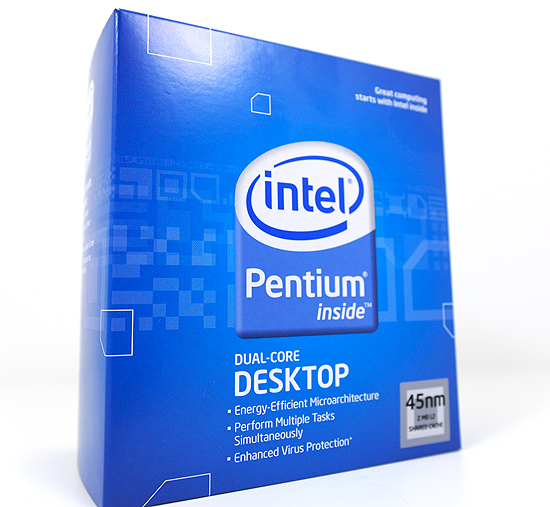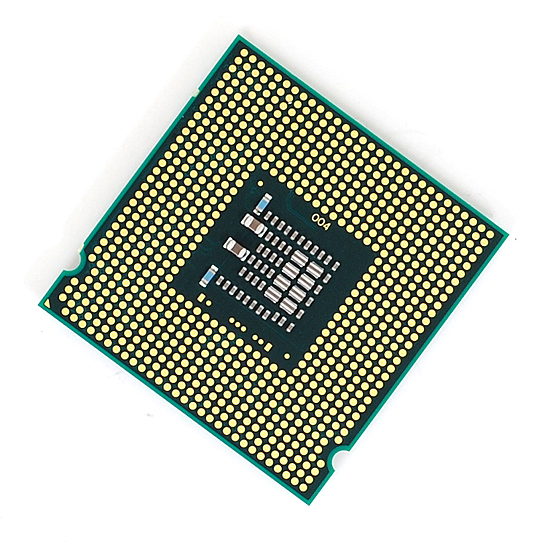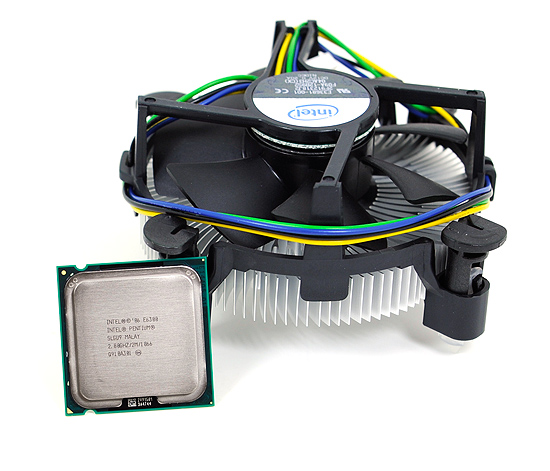The Athlon II X2 & Phenom II X2: 45nm Dual-Core from AMD
by Anand Lal Shimpi on June 2, 2009 12:00 AM EST- Posted in
- CPUs
Intel’s Response: The Pentium E6300
AMD has two new dual-core chips priced at $87 and $102, both run at or around 3.0GHz and have a fair amount of cache. The Athlon II X2 250 has a 1MB L2 per core (2MB total) while the Phenom II X2 550 BE has a large 6MB L3 to share between its two cores. These are both very healthy sounding processors, borderline scary if you’re Intel.

The Pentium E6300
In the blue corner we have the new Pentium E6300. It’s a 45nm monolithic dual-core part, just like the Athlon II X2. It has a 2MB L2 cache also like the Athlon II X2, albeit shared between the two cores which is potentially an upside. Unlike previous Pentium for Desktop (that’s the official name) processors, the E6300 uses a 1066MHz FSB and it supports Intel’s VT. The problem? The E6300 only runs at 2.80GHz; AMD has a clock speed advantage.


In our first Phenom II review I talked about how AMD needs a clock speed advantage to compete. Compared to a large-cache Core 2, that’s very true, but the E6300 doesn’t have a healthy 6MB L2 for two cores. It’s only got 2MB. All of the sudden things aren’t looking so rosy for Intel.

An inherent advantage of Intel’s Core architecture is its 4-issue front end (which in some cases can behave like a 5-issue front end). The problem is feeding such a beast requires very fast memory access. The Pentium E6300 is still based on the same architecture as the Core 2 Duo, meaning it has no on-die memory controller. Rob it of a decent sized cache and its performance suffers. A quick look at Bench shows us that even an extra megabyte of cache helps tremendously:
| Processor | SYSMark 2007 Overall |
| Intel Core 2 Duo E7500 (2.93GHz/3MB L2) | 173 |
| Intel Pentium E6300 (2.80GHz/2MB L2) | 158 |
Note that when Conroe first launched some parts (the Core 2 Duo E6300 funny enough) only had a 2MB L2. The problem is that was nearly three years ago; applications have grown in size and so have their demands from processors. What was acceptable back then is now not. I’d like to see Intel move its 3MB L2 caches down to these sub-$100 price points. But I’ll let the benchmarks decide whether or not it’s necessary.
| Processor | Clock Speed | L2 Cache | TDP | Price |
| Intel Core 2 Quad Q9650 | 3.00GHz | 12MB | 95W | $316 |
| Intel Core 2 Quad Q9550 | 2.83GHz | 12MB | 95W | $266 |
| Intel Core 2 Quad Q9400 | 2.66GHz | 6MB | 95W | $213 |
| Intel Core 2 Quad Q9300 | 2.50GHz | 6MB | 95W | $213 |
| Intel Core 2 Quad Q8400 | 2.66GHz | 4MB | 95W | $183 |
| Intel Core 2 Quad Q8300 | 2.50GHz | 4MB | 95W | $183 |
| Intel Core 2 Quad Q8200 | 2.33GHz | 4MB | 95W | $163 |
| Intel Core 2 Duo E8600 | 3.33GHz | 6MB | 65W | $266 |
| Intel Core 2 Duo E8500 | 3.16GHz | 6MB | 65W | $183 |
| Intel Core 2 Duo E8400 | 3.00GHz | 6MB | 65W | $163 |
| Intel Core 2 Duo E7500 | 2.93GHz | 3MB | 65W | $133 |
| Intel Core 2 Duo E7400 | 2.80GHz | 3MB | 65W | $113 |
| Intel Core 2 Duo E7300 | 2.66GHz | 3MB | 65W | $113 |
| Intel Pentium E6300 | 2.80GHz | 2MB | 65W | $84 |
| Intel Pentium E5400 | 2.70GHz | 2MB | 65W | $84 |
| Intel Pentium E5300 | 2.60GHz | 2MB | 65W | $74 |
| Intel Pentium E5200 | 2.50GHz | 2MB | 65W | $64 |
| Intel Pentium E2220 | 2.40GHz | 1MB | 65W | $64 |
| Intel Pentium E2200 | 2.20GHz | 1MB | 65W | $64 |
| Intel Celeron E1500 | 2.20GHz | 512KB | 65W | $53 |
| Intel Celeron E1400 | 2.00GHz | 512KB | 65W | $43 |
| Intel Celeron 450 | 2.20GHz | 512KB | 35W | $53 |
| Intel Celeron 440 | 2.00GHz | 512KB | 35W | $44 |
| Intel Celeron 430 | 1.80GHz | 512KB | 35W | $34 |










55 Comments
View All Comments
TA152H - Tuesday, June 2, 2009 - link
I agree with almost everything you say, I only have a small caveat.Intel chips will suffer much less from this than AMD, since they have an inclusive cache architecture, and can readily read the information from the L3 cache. I still think AMD has an exclusive cache arrangement, which I really think they should change with regards to the L3 cache for reasons just like the one you mention.
For what's it's worth, Microsoft screwed Intel 14 years back when the Pentium Pro was released. Naturally, Intel got the blame for having miserable 16-bit performance (it was related to segmentation, which was part of all the 16-bit modes, and technical, even 32-bit mode even though it was transparent), because Microsoft told them the world will be 32-bit by then. Of course Windows 95 had a lot of legacy code, and Windows NT, which we called "Not There" at the time, was about as common as a 20 year old virgin in western Europe. So, Intel took the blame, just like AMD is now, despite, once again, Microsoft's incompetence.
Really, if you think about it, the ability to clock the processors differently could be a very useful features, except for the fact Winblows can't use it properly.
Good
TA152H - Tuesday, June 2, 2009 - link
First, I like seeing the Pentium 4s in the benchmarks, it was kind of interesting. They did better than I thought they would, and it makes me even more curious what they would be like on 45nm, since their clock speeds would probably be astronomical (since 45nm has much better power characteristics, and the clock speed limiter on the Pentium 4 was power use/heat).But, anyway, why not use the Pentium 4 670 (3.8 GHz), or Pentium EE 965 Extreme Edition (3.73 GHz) processors? Why use the next to fastest ones?
Don't get me wrong, it was still informative, but I would have liked to see the fastest measured against today's processors, not one step removed. Even so, it was nice to see them, so it's just a minor complaint. I'm looking forward to seeing the Nano.
strikeback03 - Wednesday, June 3, 2009 - link
Might not have had any around. Figure the "best of breed" were the most likely to be either sold or go in a system for some family member when they were no longer needed for comparison duties.ShangoY - Tuesday, June 2, 2009 - link
I am curious as to why the current cheapest Intel quad core were not included in the benches yet you bothered to go grab the previously $999 Pentium 4 and then also included the Phenom X4 940.Gary Key - Tuesday, June 2, 2009 - link
http://www.anandtech.com/bench/default.aspx?b=2">http://www.anandtech.com/bench/default.aspx?b=2 - You can compare them here.Kenzid - Tuesday, June 2, 2009 - link
Does any body know why AMD transistor density is very low compare to Intel? Is this because of Intel High K metal process or the architechture?Goty - Tuesday, June 2, 2009 - link
It's more than likely due to the fact that Intel has much higher cache densities than AMD does. It probably had very little to nothing to do with the actual process (well, beyond the geometry size, that is).TA152H - Tuesday, June 2, 2009 - link
What are you basing that on?Typically, cache is very dense, so you will notice transistor count increasing disproportionately to size as you add cache.
With respect to the Athlon II X2 being larger than the Penryn, that's not really a bad thing, since it does more too; the Penryn needs a memory controller on the chipset that the Athlon II does not.
Kenzid - Tuesday, June 2, 2009 - link
Based on above die size chart. Core2Duo 107mm2 and 410million transistors while Athlon II has only 234million transistors on 117mm2. It's almost half of the number of Intel used on theirs. IMC take that much space?TA152H - Tuesday, June 2, 2009 - link
Well, take a look at the Pentium version, and you'll see the what I was saying about the cache. We both can agree it's the same core, but one has a larger cache.The Pentium is 82 mm2, with 228 million transistors, with a 2.064 megabytes of cache (L1 + L2). But, since 1 megabyte is disabled, it's really 3.064, like the other Wolfdale's have. The 6 MB version of the Core 2 is 107 mm2 with 410 million transistors.
So, you can see that adding 3 MB of cache increased the transistor count by 182 million, but the size by only 25 mm2. Or, in other words, it increased transistors by about 80%, but size by about 31%. So, cache does increase transistor count disproportionately to die size.
Oh, and yes, the IMC is quite large. You can view some of the pictures of the CPU die to see it, but it's far from insignificant in size.